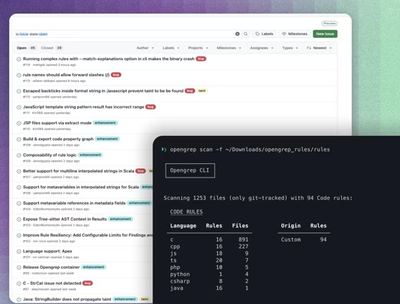Eyes.Cypress
Applitools Eyes SDK for Cypress.
Installation
Install npm package
Install Eyes.Cypress as a local dev dependency in your tested project:
npm install --save-dev @applitools/eyes.cypress
Configure plugin and commands
Automatic configuration
Run the following command in your terminal:
npx eyes-setup
The above command will add the necessary imports to your cypress pluginsFile and supportFile, as described in the manual configuration below.
Manual configuration
Configure Eyes.Cypress plugin
Eyes.Cypress acts as a Cypress plugin, so it should be configured as such.
Unfortunately there's no easy way to do this automatically, so you need to manually add the following code to your pluginsFile:
Important: add this code after the definition of module.exports:
require('@applitools/eyes.cypress')(module)
Normally, this is cypress/plugins/index.js. You can read more about it in Cypress' docs here.
Configure custom commands
Eyes.Cypress exposes new commands to your tests. This means that more methods will be available on the cy object. To enable this, it's required to configure these custom commands.
As with the plugin, there's no automatic way to configure this in cypress, so you need to manually add the following code to your supportFile:
import '@applitools/eyes.cypress/commands'
Normally, this is cypress/support/index.js. You can read more about it in Cypress' docs here.
Applitools API key
In order to authenticate via the Applitools server, you need to supply the Eyes.Cypress SDK with the API key you got from Applitools. Read more about how to obtain the API key here.
To to this, set the environment variable APPLITOOLS_API_KEY to the API key before running your tests.
For example, on Linux/Mac:
export APPLITOOLS_API_KEY=<your_key>
npx cypress open
And on Windows:
set APPLITOOLS_API_KEY=<your_key>
npx cypress open
It's also possible to specify the API key in the applitools.config.js file. The property name is apiKey. For example:
module.exports = {
apiKey: 'YOUR_API_KEY',
...
}
See the Advanced configuration section below for more information on using the config file.
Usage
After completing the configuation (either automatic or manual) and defining the API key, you will be able to use commands from Eyes.Cypress in your cypress tests to take screenshots and use Applitools Eyes to manage them:
Example
describe('Hello world', () => {
it('works', () => {
cy.visit('https://applitools.com/helloworld');
cy.eyesOpen({
appName: 'Hello World!',
testName: 'My first JavaScript test!',
browser: { width: 800, height: 600 },
});
cy.eyesCheckWindow('Main Page');
cy.get('button').click();
cy.eyesCheckWindow('Click!');
cy.eyesClose();
});
});
Best practice for using the SDK
Every call to cy.eyesOpen and cy.eyesClose defines a test in Applitool Eyes, and all the calls to cy.eyesCheckWindow between them are called "steps". In order to get a test structure in Applitools that corresponds to the test structure in Cypress, it's best to open/close tests in every it call. This can be done via the beforeEach and afterEach functions that Cypress provides (via the mocha test runner).
After adjusting the example above, this becomes:
describe('Hello world', () => {
beforEach(() => {
cy.eyesOpen({
appName: 'Hello World!',
browser: { width: 800, height: 600 },
});
});
afterEach(() => {
cy.eyesClose();
});
it('My first JavaScript test!', () => {
cy.visit('https://applitools.com/helloworld');
cy.eyesCheckWindow('Main Page');
cy.get('button').click();
cy.eyesCheckWindow('Click!');
});
});
Applitools will take screenshots and perform the visual comparisons in the background. Performance of the tests will not be affected during the test run, but there will be a small phase at the end of the test run that waits for visual tests to end.
Note: In Cypress interactive mode (cypress open) there is a bug that exceptions in root level after statements don't appear in the UI. They still appear in the browser's console, and considered failures in cypress run. See this issue for more information and tracking.
Commands
In addition to the built-in commands provided by Cypress, like cy.visit and cy.get, Eyes.Cypress defines new custom commands, which enable the visual testing with Applitools Eyes. These commands are:
Open
Create an Applitools test.
This will start a session with the Applitools server.
cy.eyesOpen({
appName: '',
testName: ''
});
It's possible to pass a config object to eyesOpen with all the possible configuration properties. Read the Advanced configuration section for a detailed description.
Check window
Generate a screenshot of the current page and add it to the Applitools Test.
cy.eyesCheckWindow(tag)
OR
cy.eyesCheckWindow({ tag: 'your tag', sizeMode: 'your size mode' })
Arguments to cy.eyesCheckWindow
-
tag (optional): A logical name for this check.
-
sizeMode (optional): Possible values are:
full-page: This is the default value. It means a screenshot of everything that exists in the DOM at the point of calling eyesCheckWindow will be rendered.viewport: Only a screenshot the size of the browser will be rendered (the size of the browser can be set in the call to cy.eyesOpen - see advanced configuration below).selector: Take a screenshot of the content of the element targeted by css or xpath selector. It's necessary to specify the value of the selector in the selector argument.region: Take a screenshot of a region of the page, specified by coordinates. It's necessary to specify the value of the region in the region argument.
-
selector (optional): In case sizeMode is selector, this should be the actual css or xpath selector to an element, and the screenshot would be the content of that element. For example:
cy.eyesCheckWindow({
sizeMode: 'selector',
selector: {
type: 'css',
selector: '.my-element'
}
});
cy.eyesCheckWindow({
sizeMode: 'selector',
selector: {
type: 'xpath',
selector: '//button[1]'
}
});
cy.eyesCheckWindow({
sizeMode: 'selector',
selector: '.my-element'
});
region (optional): In case sizeMode is region, this should be an object describing the region's coordinates. For example:
cy.eyesCheckWindow({
sizeMode: 'region',
region: {top: 100, left: 0, width: 1000, height: 200}
});
ignore (optional): A single or an array of regions to ignore when checking for visual differences. For example:
cy.eyesCheckWindow({
ignore: [
{top: 100, left: 0, width: 1000, height: 100},
{selector: '.some-div-to-ignore'}
]
});
floating (optional): A single or an array of floating regions to ignore when checking for visual differences. More information about floating regions can be found in Applitools docs here. For example:
cy.eyesCheckWindow({
floating: [
{top: 100, left: 0, width: 1000, height: 100, maxUpOffset: 20, maxDownOffset: 20, maxLeftOffset: 20, maxRightOffset: 20},
{selector: '.some-div-to-float', maxUpOffset: 20, maxDownOffset: 20, maxLeftOffset: 20, maxRightOffset: 20}
]
});
scriptHooks (optional): A set of scripts to be run by the browser during the rendering. It is intended to be used as a means to alter the page's state and structure at the time of rendering.
An object with the following properties:
beforeCaptureScreenshot: a script that runs after the page is loaded but before taking the screenshot. For example:
cy.eyesCheckWindow({
scriptHooks: {
beforeCaptureScreenshot: "document.body.style.backgroundColor = 'gold'"
}
})
sendDom (optional): A flag to specify whether a capture of DOM and CSS should be taken when rendering the screenshot. The default value is true. This should only be modified to troubleshoot unexpected behavior, and not for normal production use.
cy.eyesCheckWindow({sendDom: false})
-
matchLevel (optional): The method to use when comparing two screenshots, which expresses the extent to which the two images are expected to match. Possible values are Strict, Exact, Layout and Content. Read more about match levels here.
-
layout (optional): A single or an array of regions to match as layout level. For example:
cy.eyesCheckWindow({
layout: [
{top: 100, left: 0, width: 1000, height: 100},
{selector: '.some-div-to-test-as-layout'}
]
});
strict (optional): A single or an array of regions to match as strict level. For example:
cy.eyesCheckWindow({
strict: [
{top: 100, left: 0, width: 1000, height: 100},
{selector: '.some-div-to-test-as-strict'}
],
matchLevel: 'Layout'
});
Close
Close the applitools test and check that all screenshots are valid.
It is important to call this at the end of each test, symmetrically to eyesOpen(or in afterEach(), see Best practice for using the SDK).
Close receives no arguments.
cy.eyesClose();
Concurrency
The default level of concurrency for free accounts is 1. This means that visual tests will not run in parallel during your tests, and will therefore be slow.
If your account does support a higher level of concurrency, it's possible to pass a different value by specifying it in the property concurrency in the applitools.config.js file (see Advanced configuration section below).
If you are interested in speeding up your visual tests, contact sdr@applitools.com to get a trial account and faster tests with more concurrency.
Advanced configuration
There are 3 ways to specify test configuration:
- Arguments to
cy.eyesOpen() - Environment variables
- The
applitools.config.js file
The list above is also the order of precedence, which means that if you pass a property to cy.eyesOpen it will override the environment variable, and the environment variable will override the value defined in the applitools.config.js file.
Here are the available configuration properties:
| Property name | Default value | Description |
|---|
testName | The value of Cypress's test title | Test name. If this is not specified, the test name will be the title of the it block where the test is running. |
browser | { width: 800, height: 600, name: 'chrome' } | The size and browser of the generated screenshots. This doesn't need to be the same as the browser that Cypress is running. It could be a different size and also a different browser. Currently, firefox and chrome are supported. For more info, see the browser section below. |
concurrency | 1 | The maximum number of tests that can run concurrently. The default value is the allowed amount for free accounts. For paid accounts, set this number to the quota set for your account. |
saveDebugData | false | Whether to save troubleshooting data. See the troubleshooting section of this doc for more info. |
batchId | random | Provides ability to group tests into batches. Read more about batches here. |
batchName | undefined | Provides a name to the batch. |
baselineEnvName | undefined | The name of the environment of the baseline. |
envName | undefined | A name for the environment in which the application under test is running. |
ignoreCaret | false | Whether to ignore or the blinking caret or not when comparing images. |
matchLevel | undefined | The method to use when comparing two screenshots, which expresses the extent to which the two images are expected to match. Possible values are Strict, Exact, Layout and Content. Read more about match levels here. |
matchTimeout | undefined | Sets the maximum time (in ms) a match operation tries to perform a match. |
branchName | undefined | The name of the branch. |
baselineBranchName | undefined | The name of the baseline branch. |
parentBranchName | undefined | Sets the branch under which new branches are created. |
saveFailedTests | false | Set whether or not failed tests are saved by default. |
saveNewTests | false | Set whether or not new tests are saved by default. |
properties | undefined | Custom properties for the eyes test. The format is an array of objects with name/value properties. For example: [{name: 'My prop', value:'My value'}]. |
compareWithParentBranch | false | |
ignoreBaseline | false | |
The following configuration properties cannot be defined using the first method of passing them to cy.eyesOpen. They should be defined either in the applitools.config.js file or as environment variables.
| Property name | Default value | Description |
|---|
apiKey | undefined | The API key used for working with the Applitools Eyes server. See more info in the Applitools API key section above |
showLogs | false | Whether or not you want to see logs of the Eyes.Cypress plugin. Logs are written to the same output of the Cypress process. |
serverUrl | Default Eyes server URL | The URL of Eyes server |
proxy | undefined | Sets the proxy settings to be used in network requests to Eyes server. This can be either a string to the proxy URI, or an object containing the URI, username and password.
For example:
{uri: 'https://myproxy', username: 'my_user', password: 'my_password'} |
isDisabled | false | If true, all calls to Eyes.Cypress commands will be silently ignored. |
failCypressOnDiff | true | If true, then the Cypress test fails if an eyes visual test fails. If false and an eyes test fails, then the Cypress test does not fail. |
tapDirPath | undefined | Directory path of a results file. If set, then a TAP file with the name eyes.tap is created in this directory, containing the Eyes test results. |
Method 1: Arguments for cy.eyesOpen
Pass a config object as the only argument. For example:
cy.eyesOpen({
appName: 'My app',
showLogs: true,
batchName: 'My batch',
...
})
Method 2: Environment variables
The name of the corresponding environment variable is in uppercase, with the APPLITOOLS_ prefix, and separating underscores instead of camel case:
APPLITOOLS_APP_NAME
APPLITOOLS_SHOW_LOGS
APPLITOOLS_BATCH_NAME
APPLITOOLS_CONCURRENCY
APPLITOOLS_SAVE_DEBUG_DATA
APPLITOOLS_BATCH_ID
APPLITOOLS_BATCH_NAME
APPLITOOLS_BASELINE_ENV_NAME
APPLITOOLS_ENV_NAME
APPLITOOLS_IGNORE_CARET
APPLITOOLS_IS_DISABLED
APPLITOOLS_MATCH_LEVEL
APPLITOOLS_MATCH_TIMEOUT
APPLITOOLS_BRANCH_NAME
APPLITOOLS_BASELINE_BRANCH_NAME
APPLITOOLS_PARENT_BRANCH_NAME
APPLITOOLS_SAVE_FAILED_TESTS
APPLITOOLS_SAVE_NEW_TESTS
APPLITOOLS_COMPARE_WITH_PARENT_BRANCH
APPLITOOLS_IGNORE_BASELINE
Method 3: The applitools.config.js file
It's possible to have a file called applitools.config.js at the same folder location as cypress.json. In this file specify the desired configuration, in a valid JSON format. For example:
module.exports = {
appName: 'My app',
showLogs: true,
batchName: 'My batch'
...
}
Configuring the browser
Eyes.Cypress will take a screenshot of the page in the requested browser, the browser can be set in the applitools.config.js or by passing it to cy.eyesOpen.
It's also possible to send an array of browsers, for example:
cy.eyesOpen({
...
browser: [
{width: 800, height: 600, name: 'firefox'},
{width: 1024, height: 768, name: 'chrome'}
]
}
Note: that if only a single browser is set, then Eyes.Cypress changes the Cypress application viewport to that viewport size.
Device emulation
To enable chrome's device emulation, it's possible to send a device name and screen orientation, for example:
cy.eyesOpen({
...
browser: {
deviceName: 'iPhone X',
screenOrientation: 'landscape',
name: 'chrome'
}
}
Possible values for screen orientation are landscape and portrait, and if no value is specified, the default is portrait.
The list of device names is taken from chrome devtools predefined devices, and can be obtained by running the following command in a unix-based shell (installing jq might be needed):
curl -s https://raw.githubusercontent.com/chromium/chromium/0aee4434a4dba42a42abaea9bfbc0cd196a63bc1/third_party/blink/renderer/devtools/front_end/emulated_devices/module.json | jq '.extensions[].device.title'
In addition, it's possible to use chrome's device emulation with custom viewport sizes, pixel density and mobile mode, by passing deviceScaleFactor and mobile in addition to width and height. For example:
cy.eyesOpen({
...
browser: {
width: 800,
height: 600,
deviceScaleFactor: 3,
mobile: true,
name: 'chrome'
}
}
Setting a timeout
At the end of the test run, Eyes.Cypress will wait for the results of all visual tests. There's a default timeout of 2 minutes between the end of the test run and the end of the visual tests (although it should not take so long normally!).
It's possible to change that default by setting the configuration variable eyesTimeout, in one of the varios ways to configure Cypress, as described in the Cypress plugins documentation.
Troubleshooting
If issues occur, the saveDebugData config property can be set to true in order to save helpful information. The information will be saved under a folder named .applitools in the current working directory. This could be then used for getting support on your issue.



